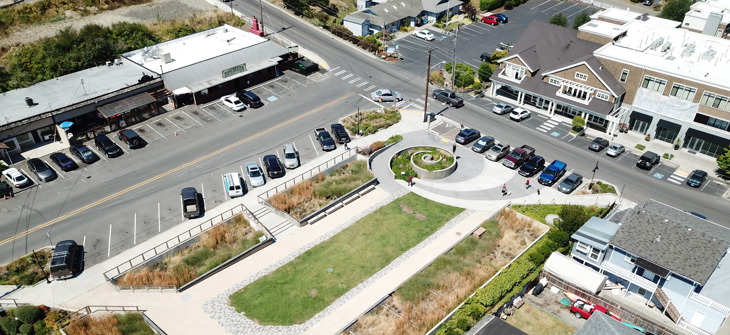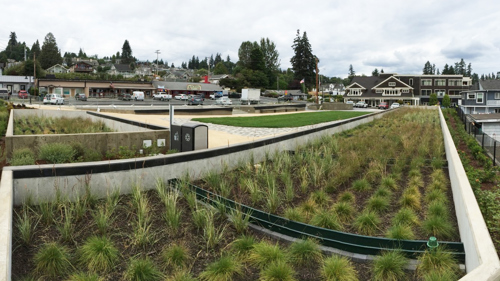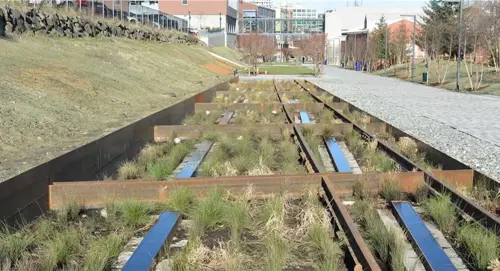
Stormwater Parks Part 2: The Role of High-Rate Bioretention in Successful Stormwater Parks
Overcoming Urban Space Constraints with High-Rate Bioretention in Stormwater Parks
In the first of our two-part series on stormwater parks, we examined what they are, how they work, and how they benefit local communities. Stormwater parks represent a forward-thinking approach to urban water management, but they have one major drawback—their size. Land space is a significant challenge for stormwater parks in urban areas for several reasons:
1. Limited Vacant or Undeveloped Land: As urban areas become more built-out, vacant land suitable for stormwater parks becomes increasingly rare. Many cities face the challenge of retrofitting existing, developed areas with green infrastructure, which often requires redesigning existing land uses to incorporate stormwater management features like parks.
2. Competing Land Uses: In cities, land is a precious resource with multiple competing needs, such as housing, transportation, and infrastructure. Allocating space for stormwater management, especially in large-scale parks, must compete with these other demands.
3. High Cost of Land: The cost of land in urban environments is typically very high. This makes it difficult to secure large areas for stormwater parks, as developers and local governments may prioritize other land uses that provide immediate economic or social benefits over green infrastructure projects.
4. Flooding Concerns: Stormwater parks need to be large enough to manage significant runoff, but the limited space available may not be sufficient to handle the volume of water generated during heavy storms. This leads to challenges in finding land that is both large enough and suitable for the required stormwater functions.
5. Balancing Multiple Functions: Stormwater parks are intended to serve multiple purposes—stormwater management, recreation, and ecological restoration. However, balancing these functions with space constraints can be tricky. For example, the land area needed for effective water treatment may conflict with the space required for recreational activities or natural habitats, complicating the design and use of the park.
6. Safety issues: Water features must be designed to limit health and safety risk to people, pets and wildlife as they interact with stormwater and captured pollutants.
Given these challenges, urban planners and engineers need to find creative solutions—such as integrating high-rate bioretention systems that maximize the potential of limited land while still providing effective stormwater management. High-rate bioretention refers to an advanced form of bioretention, such as Filterra Bioscape, that is specifically designed to treat stormwater runoff at a faster rate than traditional bioretention systems. It utilizes a combination of engineered soils, plantings, and infiltration techniques to enhance the system's ability to filter and manage larger volumes of stormwater in a relatively small footprint. High-rate biofiltration systems can be a powerful tool to address the challenge of limited space in stormwater parks, especially in urban areas where available land is scarce. Here's how it can help:
1. Increased Efficiency/Compact Design: By using specially engineered soils, high-rate bioretention systems can filter water more quickly than traditional systems. This higher efficiency means less space is needed to handle the same amount of stormwater, which is particularly valuable when trying to balance stormwater management with recreational and ecological goals in a park setting.
2. Integration into Landscape Features: High-rate bioretention can be integrated seamlessly into the park's landscaping features while serving their functional purpose, making the most of the available space.
3. Dual Functionality: High-rate bioretention not only treats stormwater but also contributes to the park's ecological restoration and aesthetic value. The plants and trees used can enhance the park's biodiversity, providing habitats for wildlife, and improving the overall environmental quality of the area.
4. Safety: due to their higher infiltration rate soils, water ponding at the surface drains quickly, reducing the risk of accidents, mosquito breeding or other nuisances
The state of Washington is a leader in creating stormwater parks, showcasing innovative solutions to manage runoff and improve water quality. Below are examples of stormwater parks in Washington that have successfully incorporated Filterra Bioscape high-rate bioretention, highlighting the state’s commitment to sustainable infrastructure.
Manchester Stormwater Park (Kitsap County, Washington):
A half-acre park with natural and engineered stormwater infrastructure that provides treatment and flood control for a 100-acre drainage basin.

Marysville Stormwater Park (Marysville, Washington): This park treats 110 million gallons of stormwater runoff per year from 460 acres and has been recognized with the Innovative Stormwater Project Award by the Pacific Northwest Clean Water Association.

Whispering Firs Stormwater Park (Kitsap County, Washington): Built on a former trailer park site, the park manages runoff from over 115 acres of development that previously flowed untreated into a nearby creek. The project received the Innovative Stormwater Project Award from the Pacific Northwest Clean Water Association (PNCWA) and a 2019 Top Project Award from Stormwater Solutions Magazine.

Point Defiance Park Regional Treatment Facility (Tacoma, Washington): This facility provides treatment for 754 acres in a footprint of only 5,500 square feet. With over 2 million visitors each year, the city created this park to be an educational piece for the public and make the community aware of the need for stormwater BMP’s.

Prairie Line Trail (Tacoma, Washington): This facility sits alongside a beautiful bike and pedestrian trail and features six 550-square-foot custom Filterra systems with a specially designed flow distribution system to meet WA-Ecology design requirements. Due to space constraints, a high-rate bioretention system was the only landscape-based option that could treat the contributing drainage area.

High-rate bioretention is key to overcoming the space constraints of stormwater parks in urban areas. Traditional stormwater parks require significant land, which is often unavailable due to high costs, dense development, and competing land uses. High-rate bioretention systems provide a compact yet highly efficient solution by treating stormwater runoff quickly in a smaller footprint. These systems integrate seamlessly into park landscapes, enhance ecological value, and improve urban water management.
